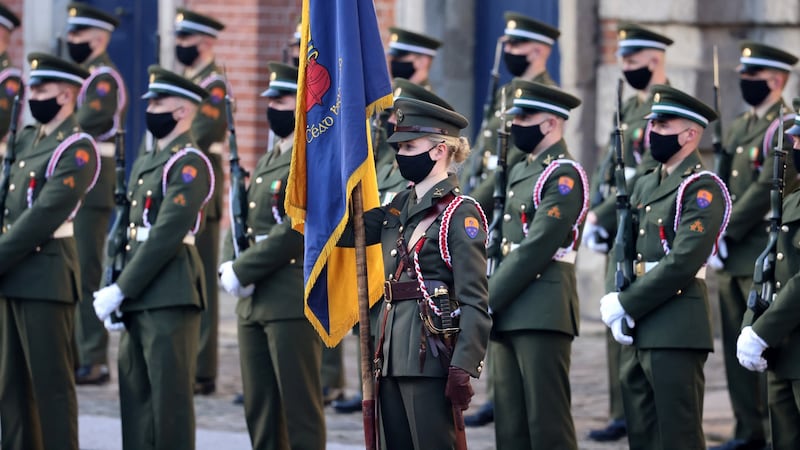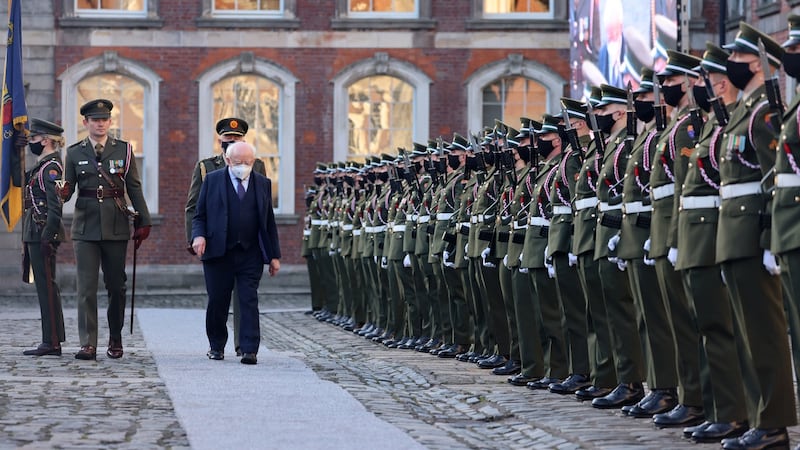[ click hereOpens in new window ]
“There is really no outstanding man in this ministry; none that can be regarded as a popular hero, and perhaps this is just the very best for Ireland at present...Most of them are suffering from overwork.”
Such was the assessment that Liam de Róiste, a pro-Treaty Sinn Féin TD for Cork Borough, recorded in his diary in October 1922.
Almost two years later, Kevin O’Higgins, vice-president of the Executive Council – the equivalent of today’s tánaiste – would recall that he and his cabinet colleagues had been “simply eight young men in City Hall standing amidst the ruins of one administration, with the foundations of another not yet laid, with wild men screaming through the keyhole”.
This set of remarks reveals much about the challenges faced by the new government in December 1922, and how they handled those challenges. Already mentally tired from the Treaty debates, they were now tasked with building the new Irish Free State, while dealing with opponents who contested its very legitimacy.
Exactly one year after the signing of the Anglo-Irish Treaty, the Free State came into formal existence on December 6th, 1922. The Provisional Government became the executive council, with WT Cosgrave as president (the title that remained in use until the 1937 Constitution created the office of the Taoiseach). Around the same time, the pro-Treaty organisation became Cumann na nGaedheal, the government party.
The birth of the State contrasted strongly with the scenes that marked the moment when the Irish Republic came into being from midnight on April 17th, 1949. Blazing tar barrels on the Dublin mountains would be seen from the city centre; crowds would throng O’Connell Street; the tricolour would fly from surrounding buildings; and chants of “up the Republic” would echo.
But on December 6th, 1922, there was no cheering. No pageantry. Despite the divisions the Treaty caused, there weren’t any protesters. Except for a new tricolour that flew above Leinster House, there was nothing to signal that the new Free State had been born.

The mood inside Leinster House was relatively sombre. Members of the government were described by one journalist as “looking cheerful, but pale”. When the Dáil assembled at 5.15pm, the viewing gallery was quiet. Visitors had not been admitted to witness this historic moment. The first official meeting of parliament in independent Ireland, which lasted about three hours, would have gone unobserved, were it not for the assembled journalists and some officials who had gathered to watch the proceedings.
This newspaper reported: "The opening meeting of the Free State was a very dull affair." At least an hour of the proceedings was taken up with complying with the oath. One of the most controversial elements of the Treaty agreement, even that did not provoke any drama, though that was not surprising. Anti-Treaty politicians had adapted Sinn Féin's policy of abstention from Westminster for the Dáil, leaving the role of opposition to Tom Johnson's Labour Party. The recorded names document those TDs who supported the Treaty and, by virtue of their absence, those who opposed.
Johnson, however, clarified that his party considered the act a formality, complying only so that they could give “effect to the will of the organised workers”.
Nominating Cosgrave to be president of the executive council, Peter Hughes, TD for Louth, suggested, "He is going to have during his term of office, perhaps, a troublesome, and perhaps a stormy time".
His observation, like those of de Róiste and O’Higgins, needs to be understood in the wider context.
Less than six months earlier, in an act that is taken as the official start of the Civil War, Michael Collins had ordered the shelling of the Four Courts. It had been held by anti-Treaty forces for about two months. Since the shelling, Arthur Griffith, president of the Provisional Government, had unexpectedly died, and 10 days later, Collins was assassinated.
Life in the Free State was punctuated by fighting, reprisals and intimidation. By the time the Free State came into formal existence, how or when that might end, could not be easily predicted.
Government buildings took on an additional function during the Civil War, becoming a refuge for ministers and their families, whose lives were potentially at risk. The floor often served as a makeshift bed.
The extent to which the threat to politicians’ lives was real became apparent on December 7th, 1922. Seán Hales, a government TD, was shot dead and Pádraig Ó Máille, the Leas Ceann Comhairle, was wounded.
The attack was shocking, but so too were the events that followed. Liam de Róiste is likely to have had the late Collins in mind when he wrote that the new cabinet did not count popular heroes amongst its ranks. But the question of popularity was not confined to personalities.
It would go beyond even policy matters and the usual opposition to be expected in political life. How Cosgrave’s government handled the attack on Hales and Ó Máille would cast a long shadow.
Four republican prisoners – Rory O'Connor, Liam Mellows, Joe McKelvey and Dick Barrett – were taken from their cells in Mountjoy prison and executed in retaliation for Hales's death. The government had clearly stepped outside the rule of law. All four of the men had been in prison since July 1922 and could, in no way, have been responsible for the murder.
The Cumann na nGaedheal government was defiant. As WT Cosgrave explained in the Dáil, there was a “diabolical conspiracy afoot” that needed to be crushed.
Executions, often carried out without trial, were the government’s favoured method to break the republican campaign. There is some ambiguity over the exact figure, with 83, 81 and, more popularly, 77 cited. The government presented these executions as necessary and justifiable acts, carried out in defence of the state during wartime.

This theme of being tough on law and order became a central tenet of Cumann na nGaedheal’s identity. Speaking to one audience while on the campaign trail in 1923, minister for education Eoin MacNeill asserted his government had restored order to the country, and that he and his colleagues could only continue to defend the country if people gave their support on polling day.
However, the executions were not easily accepted as a legitimate tactic to end the Civil War. Tom Johnson was damning in the Dáil, suggesting "you have killed the new state at its birth". He may have overstated his case, but he was certainly correct that the creation of the state had been marred by these acts.
The memory of the “77 dead”has cast a long shadow, informing propaganda and fuelling demands for a state apology.
In the weeks and months after December 6th, 1922, as the Civil War continued, the Dáil embraced the habit of practical politics. Though some structures, including that of the civil service, were retained from British rule, there was much about the functioning of the new state that had to be decided and implemented.
This included the creation of an unarmed police force, an Garda Síochána – a risky move at a time of Civil War when one member of parliament had been shot dead and another wounded – and the reorganisation of the Army.
The latter would prove particularly challenging and demonstrated that the government was also confronted with threats from within. In March 1924 Maj Gen Liam Tobin and Col Charles Dalton issued an ultimatum to the government.
They represented the Irish Republican Army Organisation, a faction within the Free State army that was loyal to Collins's legacy. They wanted the army council, including minister for defence Richard Mulcahy, removed, and for the government to do more to achieve a republic.
The so-called “army mutiny” did not amount to anything (although Mulcahy did resign), but the episode showed that civilian control had been firmly established.
Whilst dealing with various threats, Cumann na nGaedheal also embarked on an image-building project, designed to demonstrate that the Irish were capable of self-government and that the new state was a success.
It saw, amongst other things, the revival of the Tailteann Games, an Irish version of the Olympics, which attracted overseas competitors and positive media attention; the launch of the Shannon electrification scheme, with the minister for industry and commerce explaining that economic independence was as important as political independence; and an application to join the League of Nations. The basic requirement for membership was that the applicant had to be an autonomous state; that the Irish application was approved served as international recognition of the new state’s status.
Finances restricted what could be achieved. The Easter Rising and the War of Independence, along with the Civil War, had caused the destruction of infrastructure, businesses and housing.
Only after 1926 and 1927, did compensation cease to rank among the five greatest burdens on expenditure. Difficult decisions had to be made, and some were particularly unpopular.
Pensions were one of the biggest "drains" on the State's finances. Famously, minister for finance Ernest Blythe reduced the old-age pension by a shilling. Although he later reversed this cut, it went into political folklore – occasionally cited decades after as an example of political heartlessness.
Later in life, Blythe suggested that Cumann na nGaedheal’s greatest achievement was “getting things going”.
There is much truth to his assessment. The statute books for the first few years of independence document a flurry of activity. By the time a change of government occurred in 1932, the democratic structures of the new state had been firmly embedded – contrasting sharply with the faith of many of the other new nation states that had emerged at the same time.
Dr Ciara Meehan is author of The Cosgrave Party: a History of Cumann na nGaedheal







